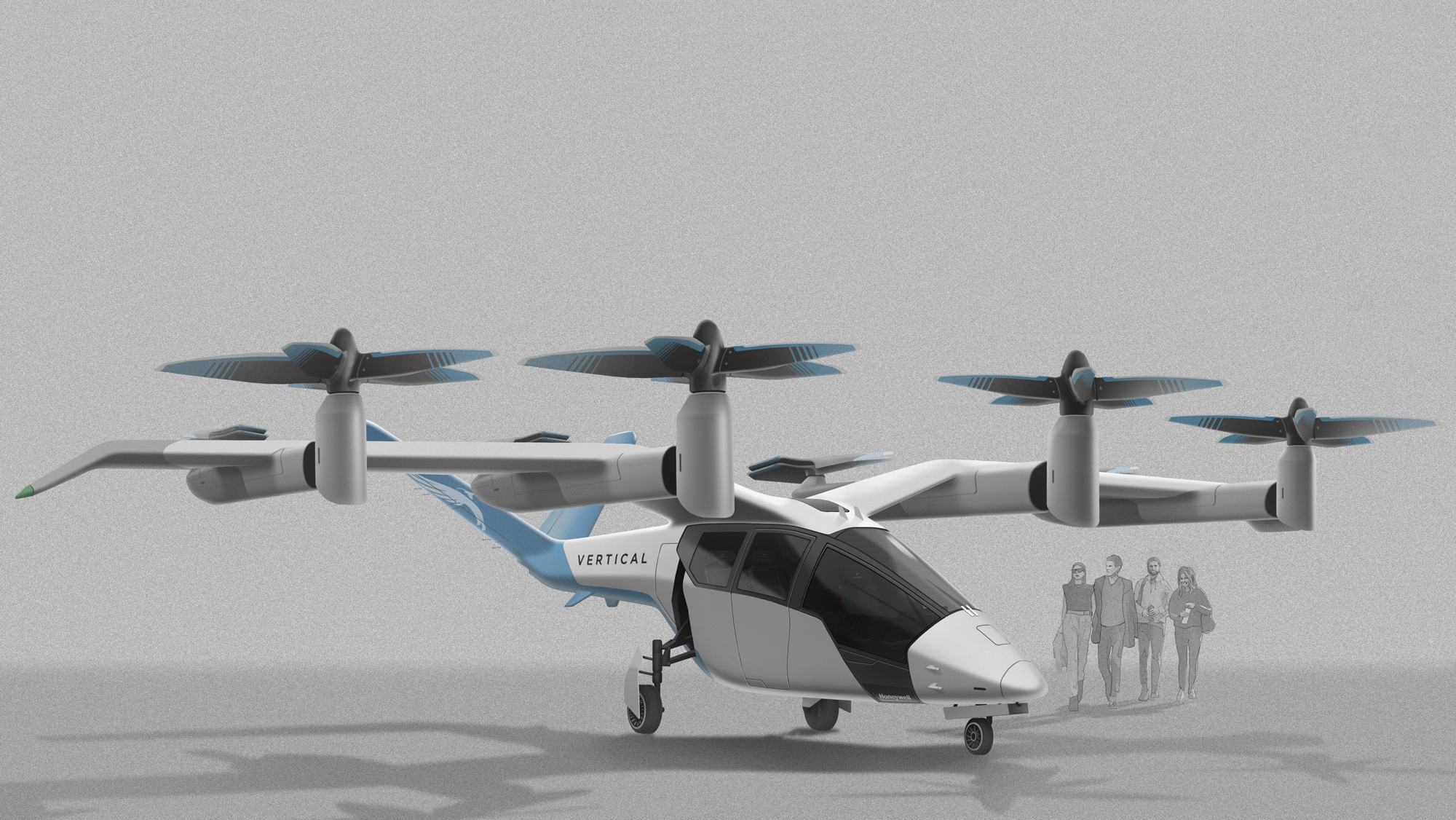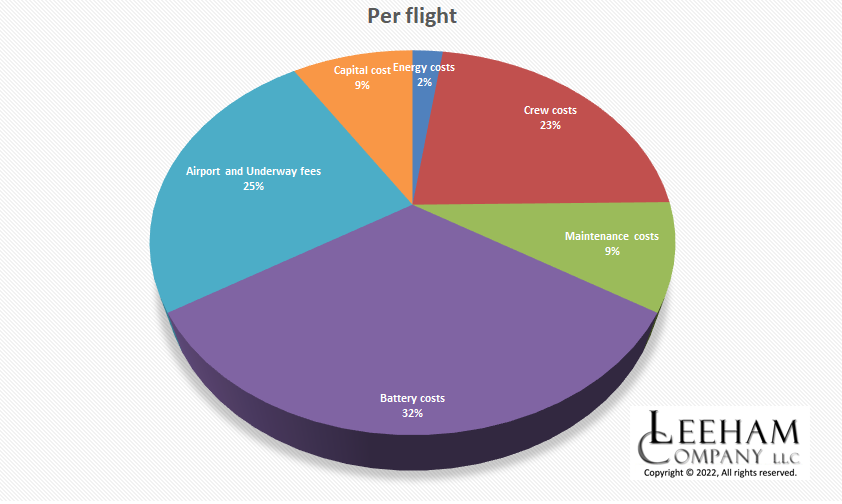Leeham News and Analysis
There's more to real news than a news release.
Bjorn’s Corner: Sustainable Air Transport. Part 44. eVTOL operating costs.
November 4, 2022, ©. Leeham News: This is a summary of the article Part 44P, eVTOL operating costs. It discusses the operational costs of a typical eVTOL flying a feeder mission from a city center to an airport.
The dominant cost factors are not the ones eVTOL companies love to discuss, like the electricity bills.

Figure 1. The Vertical Aerospace VX4 in an early rendering with similar looks to the eVTOL we discuss. Source: Vertical Aerospace.
Mission operational costs
We have analyzed the operational costs for airliners and feeder aircraft for almost a decade with our aircraft performance model. An eVTOL is not that different; the cost factors are the same, but their content differs.
We used the model to analyze the energy, crew, maintenance, airport, underway, and capital costs. The total cost for a typical city-to-airport feeder mission of 30 minutes, including procedures, would be just over $200.
The interesting part is what cost factors dominate. Figure 2 shows the cost distribution for the mission.
We see that the energy costs represent 2% of the cost mass and maintenance of the airframe with its systems, motors, and rotors 9%. The problem areas are the battery renewal costs at 32%, the cost of using the heliport, the airport, and the in-between airspace at 25%, and the cost of the pilot at 23%.
The conclusion is the cost eVTOL OEMs love to discuss; the energy cost is non-relevant to the operations costs of eVTOL air taxis.
The battery costs deserve special attention. We need more than five batteries per year, and you can’t base the renewal cost on the costs in the car industry. It produces some five billion energy-oriented cells this year. End of this decade, the eVTOL industry will demand less than 0.1% of the car industry quantity of its special, power-optimized cells.
Therefore, we have based the battery costs on what the manufacturers have told us will be the renewal cost for a 144kWh eVTOL battery at the end of the decade.




Thank you Bjorn for modelling, explaining and estimation costs, ranges and addressing the safety requirements. It seems to add up to weak operational business cases in my opinion. Likely w’ll see start-ups get quiet as fast and noisy as they came.
They niche market identified will find more practical, low risk alternatives. Some eVTOL will probably start looking at government/ defense financing / opportunities & find some funded enthusiasts. Getting wounded people from & supplies to the front line, destroying tanks etc. Until they also find out batteries/charging are unpractical.
Severe noise, flight safety and energy density discussed on this forum are constrains that won’t go away, as we deep down knew beforehand. But, ““It is difficult to get a man to understand something, when his salary depends on his not understanding it.” (Upton Sinclair). It has become an industry with enthusiasts & sincere but ill informed investors.
It will be a limited market where the UAM has its advantages of no emissions allowing operating from high rises that has AC air intakes on roofs not allowing normal helos, also the much lower noice will give benefits and increase the number of UAM heliports if it becomes a fad to have one. But the market will not take off before no pilot on board flights (Wisk..) hauling pax to/from city fincaical district to airport, unless the airport owners kills it by overcharging for ATC, landing fees, security, charging… Some private/goverment secure buildings might want them to be able to escape avoiding roads/traffic/crime. Like Silicon Valley HQ’s to SFO. It will show ones UAM’s get certified and airport regulations are issued with price lists.
Perhaps this has been covered, but the reclamation / remediation of “dead” batteries (ie batteries that have expended their useful life) has got to be a big environmental problem also.
Thanks for the analysis! Interesting to see the breakdown on the operating costs associated with this vehicle. The question that has been in my mind all along is how does this compare to a more traditional powerplant flying the same mission (like a helio)? Are the operational costs any better? I’m still where I was years ago when this concept popped up, in asking what is the advantage of it? Sure, it’s electric and that might be better for emissions, but is that the only real advantage?
5 new batteries per year implies a life of 1,000 charge cycles at 13.6 per day, 365 days per year. Is this what you used? It seems artificially conservative on a number of levels. Would be interesting to see how fewer trips but 2,000 charge cycle battery life works out. Also, did you include any cost recovery for recycling? Surely these batteries won’t have zero value at the end of their aviation life. Even with these exaggerated costs, a price of $75 to $100/seat would generate a healthy profit, would it not? Finally, your comment on claims of low energy cost being irrelevant is nonsensical: you are showing eVTOLs have very low marginal operational costs compared to helicopters.
Hi Adam,
The data you are asking for is in the Deeper discussion article. Also, look at Part 33 and 34, which were detailed articles about batteries. A reader also linked this excellent article series from an ex-professor and eVTOL designer;
https://www.linkedin.com/pulse/batteries-fuel-rob-mcdonald/ Read it!. A 2,000-flight battery for the present generation of VTOLs is not on as they are too energy-constrained (it’s all in the series). To even get to 1,000 cycles, you need to pamper the battery.
The marginal costs includes energy, battery, and fees. Of these three, the energy is less than 10%.
I am surprised about the low energy cost. My surprise comes from seeing prices for DC Fast Charging for cars and looking at how Bjorn describes a typical duty cycle for this eVTOL. It’s seems like a worst case scenario, like the $900 charge described in the article linked below. At base they’d get cheap electricity rates, of course. But these eVTOLs don’t have enough energy to get back to base on one charge, so they will have to juice up at various outposts where demand charges will dominate the cost picture. https://www.politico.com/news/magazine/2022/10/28/electric-vehicles-fueling-station-gas-utilities-infrastructure-00063398 “Kum & Go knows the pain of this math. Ken Kleemeier, its vice president of fuels, gives the example of a 150-kilowatt charging session with a $6 demand charge. Six dollars times 150 kilowatts means the electricity bill is $900. But “we charge the customer $10,” Kleemeier said. “That’s a $900 loss. That’s where the demand charges are painful. There’s no feasible way to pass that along.””
The Pivotal Helix as two charging capacities: 115 VAC 4.5 hours; and 230 VAC 75 minutes and is probably where the demand charge comes from. So if you stay near home and charge at 115VAC, you will likely never see a demand charge. And all of the conjecture on battery life is just that, conjecture. As previously stated, the average small aircraft flys 10 to 15 hours per year. The Helix could get to 100 hours per year or more. Only people who have taken flying lessens or are pilots understand the difference between tracking in 2D compared to 3D. And anyone who flies a Helix more than 100 hours per year, my hat will be off to them; a tremendous feat.
Knowing the small aircraft market is essential. The average small aircraft flys 10 to 15 hours per year. The Pivotal Helix being a new novelty may fly 100 hours per year. Suggesting your fixating on batteries is a waste of time. The Pivotal Helix has a wing span of 13 feet 7 inches, making it a street legal evtol. One can land a take off from their driveway; non pilots in class G airspace, pilots anywhere except in a TCA airport traffic area. FAA Part 103 is under modification titled MOSAIC where it is expected evtols will be able to land almost anywhere public and takeoff anywhere public. As long as the pilot is not endangering the public. The Pivotal Helix will eventually start replacing autos. Limiting 2d thinkers and forcing them to become 3 d thinkers is a good idea to me.
Also, showing an evtol with twisting nacelles, from vertical to near horizontal is not something the average pilot or the average personal evtol flyer would have an interest in. The Pivotal Helix makes this transition with the evtol having fixed wings and fixed propellers. Using their heads, the Pivotal people have built the transition from horizontal flight to vertical flight and back into the cant of the wings and the propellers. A novel and nearly fool proof method. The maintenance costs on rotating engines is astronomical. Look up the DOD Osprey. Only the DOD can afford such huge maintenance costs. Or all the rest of the evtol builders are off on the wrong foot having rotating engine nacelles. The other group of evtols keep the propellers in the vertical position and by pointing the evtol in the desired direction; move in that direction. Not a lot of horizontal flight velocity, relatively speaking with this method. The rest of the evtol world should wait for the Black Fly and Helix patents to time out. Then copy them. Seems like a no brainer to me. Why people have built rotating engine nacelles or vertical nacelles and propellers is the real mystery to me. Handicapping one self from the start is very foolish with rotating engines or vertical propellers only.